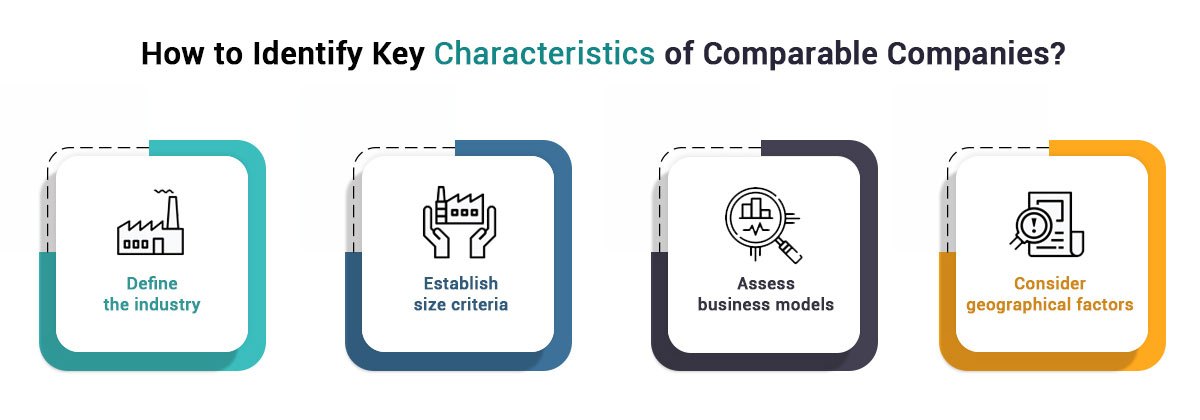Introduction
In the dynamic realm of investment banking, one analytical tool stands out as a guiding compass for making informed decisions and valuing companies: Comparable Company Analysis (CCA). This powerful technique allows financial professionals to gain valuable insights by comparing the financial performance and valuation multiples of similar companies within an industry. By diving into the depths of CCA, we unlock a pathway towards understanding its purpose, identifying key characteristics, conducting valuation multiple analysis, and ultimately driving the future of investment banking.
What is Comparable Company Analysis?
Comparable Company Analysis, also known as "comps analysis" or "trading multiples," is a method used in investment banking to determine the value of a company by comparing it to similar companies in the same industry. By examining various financial metrics and valuation multiples, investment bankers gain a comprehensive understanding of the target company's position relative to its peers. This analysis forms a crucial part of the due diligence process for mergers and acquisitions, initial public offerings (IPOs), and other financial transactions.
How to Identify Key Characteristics of Comparable Companies?
Before delving into Comparable Company Analysis, it is vital to identify the key characteristics that define comparable companies as it is a crucial step in conducting an effective Comparable Company Analysis. These characteristics serve as the basis for selecting the appropriate peer group for analysis. Let's delve deeper into each step:

-
Define the industry: Understanding the industry in which the target company operates is essential for accurate analysis. Each industry has its unique dynamics, trends, and performance metrics. By identifying the industry, investment banking professionals can narrow down the potential comparable companies to those operating in the same or closely related sectors. This ensures that the analysis remains relevant and meaningful.
-
Establish size criteria: Size matters when it comes to comparing companies. Investment analysts need to consider the target company's market capitalization, revenue, or other relevant financial metrics to determine its scale. This step helps in selecting comparable companies that fall within a similar size range. Comparing a large multinational corporation with a small startup would not provide meaningful insights. Ensuring that the companies being compared are of a similar size allows for more accurate comparisons of financial performance and valuation metrics.
-
Assess business models: Analyzing the target company's business model is crucial for identifying comparable companies with similar operations, products, or services. A company's business model influences its revenue streams, cost structure, growth potential, and risk profile. By selecting comparable companies with similar business models, investment banking professionals can ensure that the peer group represents companies with comparable fundamentals. For example, comparing a technology-focused company with a traditional manufacturing company might lead to misleading conclusions due to fundamental differences in their operations.
-
Consider geographical factors: Geographical presence plays a significant role in shaping a company's performance and prospects. Regional variations in market conditions, consumer preferences, regulations, and competitive landscapes can significantly impact a company's financial performance. When selecting comparable companies, it is crucial to consider those operating in the same regions or markets. This ensures that industry-specific dynamics and regional factors are taken into account, providing a more accurate basis for comparison.
By following these steps one can identify comparable companies that share similar characteristics with the target company. This sets the stage for a comprehensive and meaningful Comparable Company Analysis, providing valuable insights for investment decisions and financial transactions.
Valuation Multiple Analysis: Quick Review
Valuation Multiple Analysis forms an integral part of Comparable Company Analysis, providing valuable insights into the relative valuation of the target company compared to its peers. By calculating and analyzing various valuation multiples, investment bankers gain a deeper understanding of how the market values the company. Let's take a closer look at the key valuation multiples commonly used in Comparable Company Analysis:
-
Price-to-earnings (P/E) ratio: The P/E ratio is one of the most widely used valuation multiples. It compares a company's stock price to its earnings per share (EPS). The P/E ratio indicates how much investors are willing to pay for each dollar of earnings generated by the company. A higher P/E ratio suggests that investors have high expectations for the company's future earnings growth, indicating market optimism. Conversely, a lower P/E ratio may suggest undervaluation or lower growth prospects.
-
Price-to-sales (P/S) ratio: The P/S ratio compares a company's stock price to its revenue per share. This multiple provides insights into how the market values a company based on its sales performance. The P/S ratio is particularly useful for companies with low or negative earnings, such as early-stage startups or companies in highly capital-intensive industries. A higher P/S ratio implies that investors are willing to pay a premium for each dollar of sales generated by the company, indicating market confidence in its growth potential.
-
Enterprise value-to-EBITDA (EV/EBITDA) ratio: The EV/EBITDA ratio compares a company's enterprise value (market capitalization plus debt minus cash) to its earnings before interest, taxes, depreciation, and amortization (EBITDA). This multiple is commonly used when assessing companies with significant debt or varying capital structures. The EV/EBITDA ratio provides a comprehensive view of a company's valuation, taking into account both its market capitalization and its operating performance. A higher EV/EBITDA ratio may suggest a relatively higher valuation compared to its peers, while a lower ratio may indicate potential undervaluation.
It's important to note that valuation multiples should be used in conjunction with other financial and qualitative analysis to gain a holistic understanding of a company's value. Different industries and companies may have unique characteristics that require the use of specific multiples tailored to their specific dynamics. Additionally, historical trends, growth prospects, competitive positioning, and industry benchmarks should be considered when interpreting valuation multiples.
By leveraging valuation multiple analysis as part of the Comparable Company Analysis process, analysts can gain valuable insights into the relative valuation of the target company and its peers. These insights aid in making informed investment decisions, assessing potential acquisition targets, and determining fair value in financial transactions.
Comparable Company Analysis:
Comparable Company Analysis is a powerful tool used in investment banking to determine the relative value and performance of a target company by comparing it to its peer group. This analysis helps investors, analysts, and financial professionals make informed decisions regarding investments, mergers and acquisitions, and other strategic transactions.
Let's dive deeper into the step-by-step process of performing a comprehensive Comparable Company Analysis:
-
Select the peer group: The first step in the analysis is to identify and select a group of comparable companies. These companies should share key characteristics with the target company, such as industry, size, business model, and geography. Choosing the right peer group is crucial to ensure meaningful comparisons and accurate insights. A well-defined peer group provides a benchmark for evaluating the target company's performance and valuation.
-
Gather financial data: Once the peer group is established, the next step is to gather the necessary financial statements for both the target company and the comparable companies. Financial statements include income statements, balance sheets, and cash flow statements. These documents provide essential information about the companies' financial performance, liquidity, and solvency.
-
Standardize financials: Financial statements of different companies may not be directly comparable due to varying accounting practices, non-recurring items, or extraordinary events. To ensure comparability, it is necessary to standardize the financials. This process involves making adjustments to the financial statements, such as removing one-time expenses, normalizing accounting practices, or adjusting for extraordinary events. Standardizing the financials allows for a fair and accurate comparison.
-
Calculate valuation multiples: Valuation multiples are ratios derived from financial data that provide insights into a company's valuation relative to its financial performance. Common valuation multiples include the price-to-earnings (P/E) ratio, price-to-sales (P/S) ratio, and enterprise value-to-EBITDA (EV/EBITDA) ratio. These multiples are calculated using the standardized financial data for both the target company and the comparable companies. The multiples serve as a basis for comparing the target company's valuation to its peers.
-
Perform comparative analysis: With the calculated valuation multiples in hand, it's time to perform a comparative analysis. This step involves comparing the multiples of the target company with those of the comparable companies. Analyze the differences and similarities in the multiples, identifying any significant outliers or deviations. This analysis helps uncover insights into the relative valuation and performance of the target company. For example, if the target company has a higher P/E ratio compared to its peers, it may indicate that investors have higher expectations for its future earnings growth.
-
Draw conclusions: Based on the comparative analysis, draw conclusions about the target company's relative valuation and performance. Assess whether the target company is overvalued or undervalued compared to its peers. Consider other qualitative factors such as growth prospects, competitive advantages, and industry trends to gain a holistic understanding. These conclusions provide valuable insights for investment decisions, strategic planning, and financial transactions.
By following this step-by-step process, analysts can conduct a thorough and effective Comparable Company Analysis. This analysis provides a comprehensive view of the target company's relative value and performance within its industry, aiding in making informed investment decisions and shaping the future of investment banking.
Conclusion
Comparable Company Analysis emerges as a powerful weapon in the arsenal of investment bankers, providing a window into the world of finance and the future of investment banking. By understanding the purpose of CCA, analysts can unlock valuable insights for making informed investment decisions. As aspiring professionals consider a career in investment banking, mastering the art of Comparable Company Analysis will undoubtedly pave the way for success in shaping the future of finance.
FAQs
Q: What are the career prospects in investment banking?
A: Investment banking offers a range of exciting career opportunities, including roles in mergers and acquisitions, capital markets, corporate finance, and financial advisory services. Professionals in investment banking often work on high-profile deals, engage with industry leaders, and contribute to shaping the future of finance.
Q: How does Comparable Company Analysis contribute to the future of investment banking?
A: Comparable Company Analysis plays a vital role in investment banking by providing critical insights for decision-making, deal valuations, and strategic planning. As the financial landscape evolves, investment banking professionals will continue to rely on this analytical tool to navigate complex transactions and stay ahead in a rapidly changing industry.

